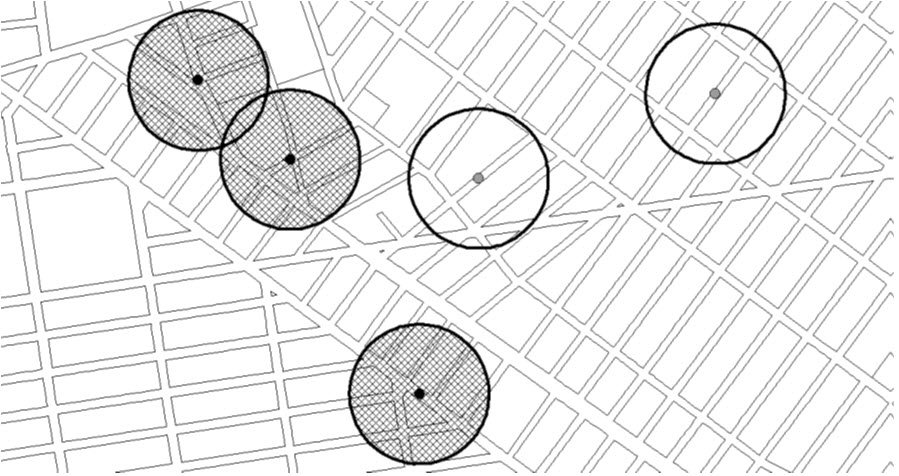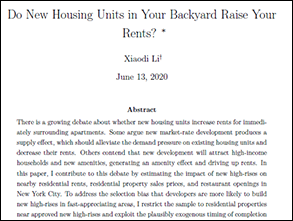Do New Housing Units Next Door Raise Your Rents?
In recent years, household income has not kept pace with housing demand. Housing costs as a share of income, or housing affordability, is a key concern for many households, particularly in urban areas. The potential of increasing housing supply to help ease housing cost burdens is often theorized but not well understood empirically. This has led to a debate as to whether new housing units will help, or hurt, nearby residents. On the one hand, new development could provide needed relief to unmet housing demand in the local market, and thus reduce local housing costs. On the other hand, new housing supply could attract high-income residents and new amenities to a neighborhood, driving up prices and leading to gentrification and displacement.
Studies looking to untangle these competing effects often struggle to find adequate data on rents over time at the local level. The research is complicated further by the fact that developers often choose to build in burgeoning neighborhoods, where rents are already on the rise. Many studies are unable to fully tackle both of these challenges to adequately isolate the causal influence of new construction on local housing prices. Therefore, we still do not fully understand the effect of new housing supply on housing prices, rents, and amenities.
In recent research sponsored by Fannie Mae’s Economic & Strategic Research Group, NYU Furman Center Doctoral Fellow Xiaodi Li uses unique data on housing construction, rents, and prices in New York City, coupled with a thoughtful research design, to tackle these challenges. The paper combines data from various sources on new construction permits, certificates of occupancy, tax lot information, building rental income, housing sales, and new restaurants across the city from 2003-2013. 1
The richness of these data allows for a research design that circumvents the potential neighborhood selection bias of developers by only looking at neighborhoods with new building permits and exploiting the differences in building completion timing on outcomes across these neighborhoods. The paper focuses on the construction of new high-rises, defined as newly built, market-rate residential properties with more than six floors. The main methodology explores the effect of these new building completions on the rental income and housing unit sale prices of properties within 500 feet of this new construction between 2003 and 2013.
Source: Li (2020) “Do New Housing Units in Your Backyard Raise Your Rents?”
Note: Black dots are completed new high-rises, and grey dots are approved new high-rises, which have not yet been completed. The event study sample includes rental buildings within shadowed and hollow circles.
First, a simple comparison of building rents shows that, as expected, developers take out residential high-rise permits in New York City neighborhoods that are growing one percentage point faster (nominally) than the rest of the city, but there is also no evidence that existing landlords experience declines in rental income once the permit is approved. Next, an econometric analysis uses a difference-in-difference framework that controls for local housing market trends pre- and post-high-rise completions. This analysis shows that, after building completion, rental income in nearby properties decreases by 1.6 percent in real terms, consistent with a slower growth rate in nearby rents—compared to other areas without new supply—as a result of new building in the community. The effect is quite localized—looking at a broader definition of the neighborhood still shows decreases in rents between 500 and 1,000 feet away—but these numbers are not statistically significant. Ultimately, the model shows that for every 10 percent increase in housing units, local rents decline by 1 percent over the next five years (in real terms). Additional analyses to distinguish whether the decline is driven by new housing supply or local dis-amenities related to the new construction (such as changes in neighborhood physical features, blocked views, or shadows) confirm that the declines are due to new supply and not dis-amenities.
Turning to local housing prices, an analogous analysis finds that residential property sale prices decline by 5.7 percent two years after the completion of a new high-rise nearby. Additionally, the paper shows that for every 10 percent increase in new condominium units within 500 feet, condominium sale prices decrease by about 1 percent, similar to the earlier findings on the reduction in rent growth.
Finally, the paper explores the effect of new construction on the opening of new restaurants, cafes, and coffee shops nearby (again, within 500 feet of a newly completed building). It finds that the completion of a new high-rise causes a 9 percent increase in local restaurant openings, or 0.11 new restaurants per property completed. There is no significant effect on the number of new grocery stores, but some Trader Joe’s and Whole Foods stores open right after the new high-rise completion. This is consistent with new construction increasing nearby amenities, although the potential positive ‘amenity effect’ is still dominated by the increase in supply driving down housing rents and prices.
By showing that new market-rate housing supply lowers nearby rents and housing prices despite also attracting new amenities, this research makes an important contribution to our understanding of the role of new housing supply in housing affordability. Local measures that prevent or restrict new housing construction overlook valuable opportunities to attract new amenities and lower housing costs for local residents.
You can read the paper here.
Jaclene Begley, Economist, Fannie Mae
Xiaodi Li, Doctoral Fellow, NYU Furman Center
September 1, 2020
Opinions, analyses, estimates, forecasts and other views reflected in this commentary should not be construed as indicating Fannie Mae's business prospects or expected results, are based on a number of assumptions, and are subject to change without notice. How this information affects Fannie Mae will depend on many factors. Changes in the assumptions or the information underlying these views could produce materially different results.




